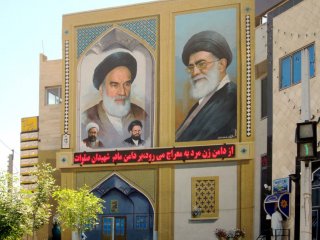In the 1990s, America and Iran Almost Fought a Bloody War
The near-conflict of the 1990s could hold lessons for present-day leaders.
Here's What You Need to Remember: “It is also important to note that the IRGC is not known to have committed any Khobar-like attacks against American targets in the immediate wake of the Clinton letter,” Byrne wrote, “which suggests that, if they were, in fact, culpable in the 1996 bombing, the message got through that Washington would retaliate the next time.”
The last time U.S. troops engaged in direct combat with Iran’s own regular forces was in April 1988, when U.S. naval forces struck Iranian ships and sea bases in retaliation for Iranian mining of the Persian Gulf.
A decade later the United States came close to attacking Iran again, this time in retaliation for a 1996 terrorist bombing that killed more than a dozen Americans. But then-president Bill Clinton instead chose to pursue a diplomatic rapprochement.
The near-conflict of the 1990s could hold lessons for present-day leaders.
Early in April 1988, the U.S. Navy frigate USS Samuel B. Roberts struck an Iranian mine while escorting tanker ships through the Gulf. No one died aboard the frigate, but the administration of U.S. president Ronald Reagan ordered the Navy to retaliate.
On April 18, 1988, American ships, planes and helicopters attacked Iranian forces, sinking two warships and killing scores of Iranian sailors. Two Americans died when their helicopter crashed.
Eight years later on June 25, 1996, the terror group Saudi Hezbollah bombed a U.S. military barracks at Khobar Towers in Saudi Arabia. Nineteen Americans died and hundreds were injured. The U.S. intelligence community suspected Saudi Hezbollah had strong ties to Iran’s Revolutionary Guard Corps militia.
“FBI and other U.S. counterterrorism officials soon concluded the IRGC had played a role in selecting the target and training the perpetrators,” Malcolm Byrne wrote at the website of The National Security Archive at George Washington University. “However, for at least two years the Saudi government rebuffed U.S. demands for access to critical evidence it had collected from interrogating suspects in Saudi custody.”
Clinton ordered U.S. Central Command to draw up strike options. The president told Richard Clarke, his counter-terrorism adviser, that he did not “want any pissant half-measures.”
“The Pentagon drew up military plans which ranged from launching cruise missiles at Iranian targets to undertaking a full-blown ground invasion of Iran,” Paul Iddon noted in a 2015 article. “It appeared, however, that the agreed plan of action was to heavily bombard Iranian military targets in its Gulf provinces with air, missile and naval attacks.”
But the retaliatory raids never got past the planning stage. Iddon cited the “circumstantial nature of the evidence and the fact the Gulf states were wary about the potential consequences.”
An Iranian election in 1999 shifted Clinton’s thinking. New Iranian president Mohammed Khatami had a reputation as a reformer. “Khatami, who apparently had not been aware of the plot, had already assumed the presidency and the White House decided that military reprisals at that point would undermine the larger objective of establishing a diplomatic opening to Tehran,” Byrne wrote.
As a kind of compromise, the Clinton administration chose instead to send a letter to Khatami that indicated Washington now had direct evidence of IRGC involvement in the Khobar attacks, insisted that Tehran bring to justice those responsible (either in Iran or Saudi Arabia), and sought Khatami’s help in ending Iranian support for terrorism. Yet, the message also stated that the United States wanted to work toward better relations with Iran and noted the attack had not occurred on Khatami’s watch but before his election.
According to published accounts and Clinton administration officials, the letter was transmitted in June 1999 to the Sultan of Oman whose foreign minister was asked to meet with Khatami and frame the presentation with statements of respect from Clinton and expressions of a genuine desire for improved ties. …
The Iranian president’s reaction was reportedly positive. However, when he discussed the new development with Supreme Leader Ali Khamenei and other senior officials, he faced a barrage of objections to both the nature and tone of the U.S. demands.
Diplomacy quickly failed, Byrne explained. “The official Iranian response, delivered to the Americans in early September 1999, was brusque, mirroring the language and tenor of the American letter, and making it clear that Iran’s ruling elite had no intention of pursuing a rapprochement with Washington under those circumstances.”
But even absent new political ties, the threat of U.S. attacks seemed to deter the IRGC from supporting another major direct attack on Americans. “It is also important to note that the IRGC is not known to have committed any Khobar-like attacks against American targets in the immediate wake of the Clinton letter,” Byrne wrote, “which suggests that, if they were, in fact, culpable in the 1996 bombing, the message got through that Washington would retaliate the next time.”
Washington has implicated the IRGC in a series of summer 2019 attacks on tanker ships in the Persian Gulf. Meanwhile, Iranian forces in June 2019 shot down a U.S. Navy surveillance drone flying in international airspace near Iran.
Those provocations aside, Iran still has demurred from supporting direct attacks on Americans.
David Axe served as Defense Editor of the National Interest. He is the author of the graphic novels War Fix, War Is Boring and Machete Squad.
This article first appeared in 2019 and is being republished due to reader interest.
Image: Flickr

